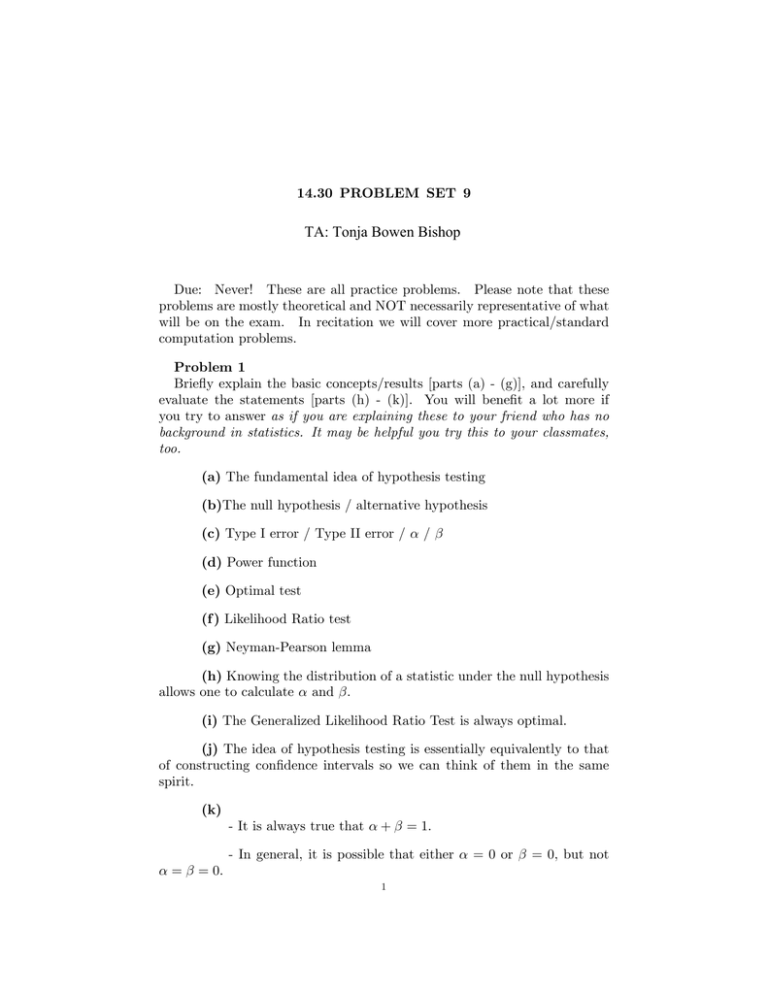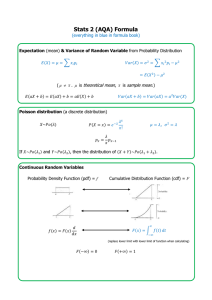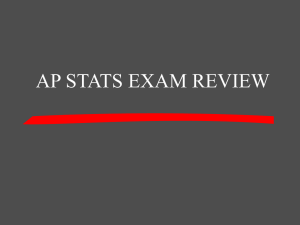TA: Tonja Bowen Bishop
advertisement

14.30 PROBLEM SET 9 TA: Tonja Bowen Bishop Due: Never! These are all practice problems. Please note that these problems are mostly theoretical and NOT necessarily representative of what will be on the exam. In recitation we will cover more practical/standard computation problems. Problem 1 Brie‡y explain the basic concepts/results [parts (a) - (g)], and carefully evaluate the statements [parts (h) - (k)]. You will bene…t a lot more if you try to answer as if you are explaining these to your friend who has no background in statistics. It may be helpful you try this to your classmates, too. (a) The fundamental idea of hypothesis testing (b)The null hypothesis / alternative hypothesis (c) Type I error / Type II error / / (d) Power function (e) Optimal test (f ) Likelihood Ratio test (g) Neyman-Pearson lemma (h) Knowing the distribution of a statistic under the null hypothesis allows one to calculate and : (i) The Generalized Likelihood Ratio Test is always optimal. (j) The idea of hypothesis testing is essentially equivalently to that of constructing con…dence intervals so we can think of them in the same spirit. (k) - It is always true that + = 1: - In general, it is possible that either = = 0: 1 = 0 or = 0; but not 2 14.30 PROBLEM SET 9 Problem 2 Suppose a sample of size 1 is taken from the pdf fY (y) = (1= )e y > 0; for the purpose of the testing H0 : = 1 versus H1 : y= ; > 1: The null hypothesis is rejected if y > 3:20: (a) Calculate the probability of committing a Type I error. (b) Calculate the probability of committing a Type II error when = 4=3. Problem 3 Consider the case where you have only one observation generated by one of the following densities: f0 (x) = 2x; 0 < x < 1; fA (x) = 2 2x; 0 < x < 1: Given a testing procedure, we denote the probability of rejecting the null when the null is true as ; and the probability of not rejecting the null when the alternative is true as : (a) i) Find the testing procedure that minimizes the sum of ii) What is the value of + and : for this test ? iii) Based on this test, do you reject the null if you observe x = 0:6 ? (b) i) Among all tests such that 0:10; …nd the test with the smallest : ii) What is the corresponding value of ? iii) Based on this test, do you reject the null if you observe x = 0:4 ? (c) Now suppose that you have ten observations from either the null or the alternative density. Propose a test statistics and the form of the critical region you want to use to test those hypotheses. (Hint: you do not have to specify the distribution of your test statistics - in specifying the form of the critical region, just indicate whether you would reject the null for small values of the statistic, large values of the statistic, or both.) Problem 4 14.30 PROBLEM SET 9 3 Suppose that you have a random sample X1 ; X2 ; :::; Xn from a normally distributed population with variance equal to one, but an unknown mean. You want to test the following hypotheses: H0 : H1 : =0 =1 Use the Neyman-Pearson lemma to derive the most powerful test for which 0:005. Problem 5 Suppose that babies’ weights at birth are normally distributed with a mean of 7 pounds and a variance of 1 pound. A particular obstetrician is suspected of giving pregnant women poor advice on diet, which would cause babies to be 1 pound lighter on average (but still have the same variance). You observe the weight of n = 10 babies that he delivers. The mean weight of the 10 babies is 6:2 pounds. (a) Suppose you want to do a test of the null hypothesis that the obstetrician is not giving poor advice against the alternative hypothesis that he is. Write down the null hypothesis and alternative hypothesis mathematically. (b) Perform a 5% test of the hypotheses from part (a). (c) What is the power of the test in part (b) ? (d) Suppose you only knew the mean of the distribution of babies’ weight, not the variance, but you did have an estimate of the variance, s2 = 1:5. Perform a 5% test of the null against alternative. (e) Would any of the answers in parts (a) - (d) change if your alternative hypothesis was that the obstetrician was doing something to a¤ ect babies’weights, either negatively or positively ? Problem 6 Suppose Xi N ( X ; 1); i = 1; :::; nX and Zj N ( Z ; 1); j = 1; :::; nZ and all the observations are independent. You want to test the hypothesis that the means are equal against the alternative that they are not. Use the statistic (X Z) : T =p 1=nX + 1=nZ (a) Characterize the support the test statistic and the critical region for the test. In other words, what values can T take on, and for which values, large, small, etc., will you reject the null ? (b) How is T distributed under the null ? 4 14.30 PROBLEM SET 9 (c) When does a size test of the null reject ? Problem 7 I observe two random i.i.d. samples from two di¤erent populations: X = (X1 ; :::; XnX ) and Y = (Y1 ; :::; YnY ). Note that nX 6= nY , in general. Each N Y ; 2Y , where X ; 2X ; Y ; and 2Y Xi N X ; 2X , and each Yi are unknown parameters. I want to test H0 : H1 : at the 0.10 level of signi…cance. 2 X 2 X = 6= 2 Y 2 Y (a) Specify a test statistic I can use (and its distribution) and the appropriate critical region to reject the null hypothesis. (b) Suppose that I collect some actual data and …nd X = (10; 7; 15; 20; 12; 8) and Y = (2; 1; 5; 3). Does the test from part a reject the null hypothesis?






